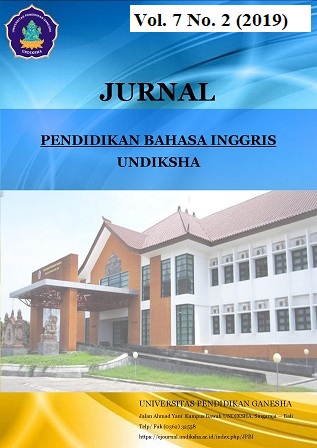IMPROVING STUDENTS’ VOCABULARY MASTERY THROUGH THE IMPLEMENTATION OF WORD MIXING TECHNIQUE FOR VIIC STUDENTS OF SMP NEGERI 5 DENPASAR IN THE ACADEMIC YEAR 2013/2014
DOI:
https://doi.org/10.23887/jpbi.v7i2.20407Abstract
Abstract
This study was a classroom based action research which aimed to find out whether Word Mixing technique can improve students’ vocabulary mastery. This study was conducted in two cycles consisting of three sessions in each cycle. There were two kinds of data (qualitative and quantitative data) which were collected through tests and writer’s diary.
The result of the tests showed that the students’ vocabulary mastery was improved in each cycle. The students’ mean score was 65.30 in pre test, 71.79 in post test 1, and improved became 81.13 in post test 2. It can be also seen on the number of students passing the test. There were 4 students passed in the pre test, 18 students in the post test 1, and 36 students in the post test 2. The result of writer’s diary also showed that the students gave positive response toward the implementation of Word Mixing Technique. Based on the results of the tests and the writer’s diary, it can be concluded that vocabulary mastery of VIIC students successfully improved by the implementation of Word Mixing technique.
Keywords: Word Mixing Technique, Vocabulary Mastery
References
Badan Standar Nasional Pendidikan. (2006). Panduan Penyusunan Kurikulum Tingkat Satuan Pendidikan Dasar dan Menengah. Accessed on January 3rd 2014 from http://bsnp-indonesia.org/id.
Blacowicz, C., Fisher, P. J., and Taffe, S. W. (2005). Integrated Vocabulary Instruction: Meeting The Need of Diverse Learner. Naperville: Learning Pointy Associate.
Chen, X., and Hao, M. (2008). The Role of Compound Awareness in Chinese Children’s Vocabulary Acquisition and Character Reading. Toronto: Springer Science+Business Media B.V.
Cooper, J. D. (2000). Literacy 4th Edition. New Jersey: Journal of Ball State University Houghton Miffin Company. Retreived from http://bookre.org/idex. Accessed on December 23rd 2013
Evi, A. (2011). Improving Vocabulary Mastery by Using Word-Mixing Strategy in Seventh Grade at SMPN 2 Singaraja. Singaraja: Universitas Pendidikan Ganesha.
Genc, B., and Bada, E. (2005). Culture in Language Learning and Teaching. The Reading Matrix, 73-84.retreived from http://www.bookre.org/TESL
Katamba, F. (1993). Morphology. Retrieved January 4, 2014, from University of Essex: http://ihjournal.com/issue-27-autumn-2009
Molinsky, S. J., and Bliss, B. (2007). Handbook of Teaching Vocabulary strategies. New Jersey: Paramount.
Montgomery, J. K. (2007). The Bridge of Vocabulary: Evidence Based Activities for Academic Success. Retreived from http://www.jumpu.net/downloader
Permendiknas No. 22 Tahun 2006 Tentang Standar Isi. Available at http://www.asbokomindo.com/diknasrokum/index. Retrieved December on 15, 2013
Reason, P., and Bradburry, H. (2001). Handbook of action research: Participative Inquiry and Practice. Retreived from http://www.bookre.org/120654
Woods, G. (2001). English Grammar for Dummies. New York: Wiley Publishing, Inc.
Zhang, X. (2011). The Analysis of Ways to memorize Vocabulary in English: Prefixes, Words' Root and Suffixes, Word Mixing, Pictorial Mnemonics, and Similar Association. Retreived from http://www.e-journalTESL.com
Downloads
Published
Issue
Section
License
Authors who publish with the Jurnal Pendidikan Bahasa Inggris Undiksha agree to the following terms:- Authors retain copyright and grant the journal the right of first publication with the work simultaneously licensed under a Creative Commons Attribution License (CC BY-SA 4.0) that allows others to share the work with an acknowledgment of the work's authorship and initial publication in this journal
- Authors are able to enter into separate, additional contractual arrangements for the non-exclusive distribution of the journal's published version of the work (e.g., post it to an institutional repository or publish it in a book), with an acknowledgment of its initial publication in this journal.
- Authors are permitted and encouraged to post their work online (e.g., in institutional repositories or on their website) prior to and during the submission process, as it can lead to productive exchanges, as well as earlier and greater citation of published work. (See The Effect of Open Access)













